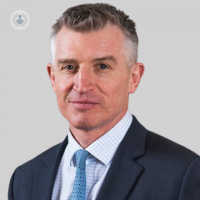Achilles tendon injuries: When is surgery required?
Escrito por:Injuries to the Achilles tendon, also known as the heel cord, can cause swelling, pain and stiffness which can, in some cases, be resolved with conservative measures. In this detailed guide, highly respected consultant orthopaedic surgeon Mr John McKinley shares his expert insight on the most common forms of Achilles tendon injury and the role of non-surgical approaches to treatment. The leading specialist also sheds light on what is involved in surgery to repair injuries to the Achilles tendon and what patients can expect from the recovery period and beyond.

What are the common causes of an Achilles tendon injury?
There are several conditions that can affect the Achilles tendon. An Achilles rupture is where the tendon snaps in two. This tends to happen during sporting activities but can sometimes occur with a fairly trivial injury, particularly in older patients.
Achilles tendinopathy (previously known as tendinitis) is where the tendon becomes swollen and painful and is often caused by overtraining or doing more activity than normal. It can affect all ages and although it is common in athletes, it is often seen in low demand patients.
There are two main types of tendinopathy and the most common of these affects the middle of the tendon. The other type, called insertional tendinopathy, is where the tendon attaches onto the heel bone. Another condition which affects the attachment of the Achilles tendon is called a Haglunds deformity which is a bone prominence on the back of the heel.
When is surgery required to treat an Achilles tendon injury?
Most Achilles tendon ruptures are now treated without surgery and there is good evidence that most can be managed in a special boot.
Surgical repair is mainly used in athletes or in patients where the tendon rupture is not recognised initially. The decision whether to have surgery or not is largely based on the activity level of the patient and the size of the gap between the tendon ends.
Most patients with Achilles tendinopathy can also be managed without surgery and physiotherapy is key to increase the strength of the tendon. Surgery is occasionally used when physiotherapy is not successful, particularly in the group where the tendon attaches onto the bone.
What are the different types of surgical procedures used for Achilles tendon injuries?
Surgical repair of a rupture can be performed using either an open or a minimally invasive (small incision) technique. Tendinopathies can be treated by removing diseased and inflamed tendon and in some cases, by transferring another tendon to bring more strength. When there is pain from where the tendon attaches onto the bone, the tendon often needs to be re-attached with special bone anchors.
How safe and effective are these operations?
Modern Achilles tendon surgery is very effective and the majority of patients will recover fully and get back to sporting activities. There are risks with any surgeries and the main risks with Achilles tendon surgery are a wound healing problem or a blood clot in the leg.
What is the recovery process like?
The recovery will depend on the initial problem and the specific type of surgery. In most cases, the patient will be in a special boot for 6-8 weeks before starting physiotherapy. It is often several months before the patient is able to return to sporting activity after Achilles surgery.
How can patients best protect their Achilles tendon after recovering from surgery?
The majority of patients will be in a boot or plaster cast following surgery. Physiotherapy is very important in the management of all Achilles tendon problems.
If you have suffered an Achilles tendon injury and wish to discuss your treatment options with Mr McKinley, you can schedule a consultation with him by visiting his Top Doctors profile.


